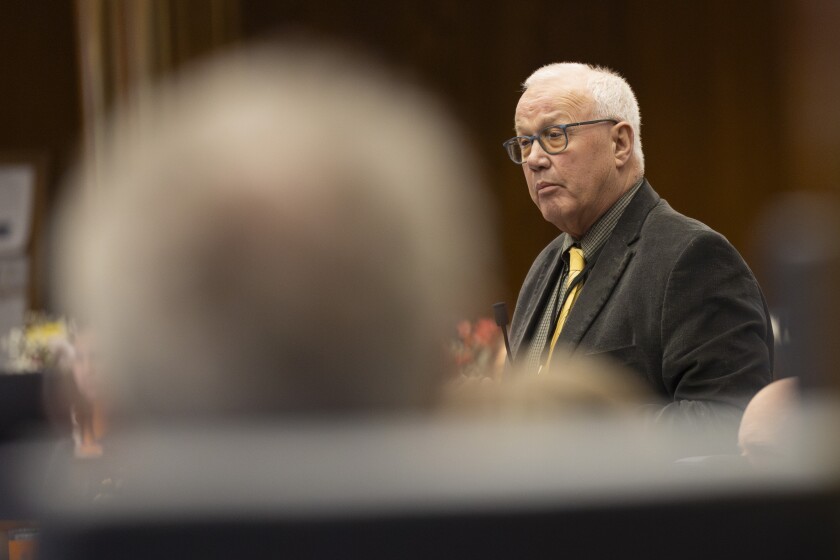North Dakota
Northwest North Dakota commission directs co-op to cut power to crypto data center

WILLISTON, N.D. — The Williams County Commission on Tuesday, June 20, voted unanimously to direct the Mountrail-Williams Electric Cooperative to shut off power to what is known as Phase II of the
Atlas Power crypto mining data center near Williston
.
On Wednesday afternoon, June 21, Commission Chairman Cory Hanson said the co-op had not yet cut the power and instead filed a petition for declaratory judgment in district court, a move Hanson said appeared to be the co-op’s way of asking a judge whether it had the authority to cut power to the data center.
Hanson said the commission voted to cut power to the data center because it had not satisfied a list of requirements the commission set in order for the center to receive a certificate of occupancy.
According to Hanson, those requirements included things like completion of final inspections and working with neighbors on a solution to sound issues created by the site, which Hanson said has been operating for some time.
Although Atlas Power had not met all of the requirements set by the county, he said, it had satisfied some, including establishing around-the-clock security at the data center.
The county commission set June 16 as the deadline for Atlas Power to meet certain stipulations.
Hanson said Wednesday county officials still had not received an explanation for why some requirements were not met.
When the $1.9-billion Atlas Power
data center project was announced in January of 2022
, North
Dakota Gov. Doug Burgum was among those marking its debut
.
Attempts to reach Kevin Washington, founder of Atlas Power, for comment were not successful.
Rick Tabish, president of Montana-based FX Solutions, which is partnered with Atlas Power on the project as the general contractor, said Wednesday that shutting off power to the data center would have “extraordinary” financial implications for both the project and the co-op. He said it appears the co-op wants to be clear on what it and the county commission have authority to do.
Tabish said Atlas Power is committed to finding a solution to noise issues, and it has secured the services of a noise-mitigation consultant to design a wall that will suppress sounds created by the data center.
The consultant is very close to providing that design, he said, adding, “I know that everybody is working really hard to meet in the middle, including the residents. Everybody is trying to be rational, and it should resolve itself soon.”

North Dakota
North Dakota House narrowly passes bill allowing babies to live with their mothers in prison

BISMARCK — North Dakota lawmakers barely passed a bill Wednesday, March 26, seeking to allow a women’s prison to create a nursery program where babies can live with their incarcerated mothers.
After a debate that lasted nearly an hour, Senate Bill 2352 passed the House with a 48-42 vote.
The legislation is likely to be reconsidered since 48 votes are required for a bill to pass and four members were absent or not voting Wednesday.
SB 2352 would authorize the Department of Corrections and Rehabilitation to allow children 18 months or younger to live with their mothers at the Heart River Correctional Center in Mandan.
The facility is currently under construction and scheduled to open in 2027, when the program would be effective.
SB 2352 has the same intent of failed Senate Bill 2115, which was struck down by the Senate in January by a 18-29 vote. Opposing lawmakers cited concerns of the bill’s uncertain, but potentially large, fiscal note.
The bill has since been slimmed from eight pages to a few sentences. Its original language would have exempted prison staff from being held liable if the child was injured — unless those injuries resulted from a negligent employee.
Liability isn’t directly addressed in what remains of the bill, but it does require the department to enact policies to protect the child.
Costs associated with implementation are based on “future liability events,” according to its fiscal note, which lists $100,000 as a ballpark figure for the 2027-29 biennium.
Allowing mothers and their young children to live together is better for both parties involved, DOCR leaders and other proponents say.
During the Wednesday debate, 14 representatives voiced varying opinions about what’s more ethical and cost-effective: keeping babies with their imprisoned mothers or putting them in the foster system instead.
“I’ve had the honor and privilege of arresting some of those women,” TJ Brown, R-Fargo, said. “I cannot prioritize the incarcerated mother’s interest over the well being of the child; while babies may not understand their surroundings, a prison environment may have far reaching effects on their development.”
Tanner Ecker / The Bismarck Tribune
Other opponents said the bill is incomplete and lacks necessary statutory oversight to protect a baby by not addressing liability.
Supporters emphasized that the bill merely authorizes the DOCR to plan for the program ahead of the new facility opening, pointing to states where similar programs have shown to reduce recidivism rates and improve the health of both mothers and their babies.
Many supporting lawmakers also referenced their time visiting with mothers who are incarcerated.

Tanner Ecker / The Bismarck Tribune
“Listening to the debate today, it (visiting the facilities) should be a requirement, not a wish,” Rep. Jon Nelson, R-Rugby, said.
“Yes, you can be honored to pick up somebody off the streets that’s on a drug-ravaged crime and think you’ve done your civic duty, but it’s a different person when they get to the Heart River facility,” Nelson continued. “These women don’t have the services that we have at the North Dakota state penitentiary. This is the hope that they look for.”
North Dakota
ND Democratic NPL and ND GOP host reorganization meetings
BISMARCK, N.D. (KFYR) – While it may seem like we just went through an election, both parties are preparing themselves for another. The North Dakota Democratic-NPL and the North Dakota GOP are working to host a series of reorganization meetings in each state district.
The two parties have gathered in the districts to hold elections for new chairs, vice chairs and other regional officers.
At its reorganization meeting at Horizon Middle School, the North Dakota Democratic-NPL had odd-numbered districts elect officers in preparation for the 2026 election cycle for legislators.
The meeting also allowed community members to air out their frustrations regarding recent legislation, such as school vouchers, and question their relevance as a North Dakota issue.
“I always like to say that our statewide candidates got over 115,000 votes in North Dakota; it’s not enough to have one ND statewide election, but that means that in every corner of the state, small towns, rural areas, big cities, there are people just like us all over the state who want a better future,” said Adam Goldwyn, chair of the ND Democratic-NPL.
At one of the ND GOP’s reorganization meetings at Solheim Elementary School, the focus was on making sure Republican legislators are listening to what the district members want.
“It’s just so critically important that they have that essential support that they need from their district, that they’re hearing from the constituents in regard to what they need and that they have that ongoing support as they serve,” said Aimee Copas, chair of the District 30 Representation.
Both parties highlight the need for North Dakotans to have their voices heard by their lawmakers.
You can see where the next district reorganization meeting for each of the parties will be held on the ND Democratic NPL and ND GOP websites.
Copyright 2025 KFYR. All rights reserved.
North Dakota
North Dakota lawmakers consider 3-cent gas tax hike

BISMARCK — North Dakota lawmakers are considering a bill that would increase the state gas tax by 3 cents per gallon, bringing it to 26 cents. The Senate Finance Committee heard arguments on the proposal Friday.
Currently, North Dakota’s gas tax stands at 23 cents per gallon. If approved, the increase would help create a county, city and township road fund.
Opponents argue that road maintenance is already funded by other sources. The bill also proposes raising the electric vehicle road use fee from $120 to $150 and increasing the plug-in hybrid vehicle road use fee from $50 to $60.
Rep. Jared Hagert, R-Emerado, who introduced the bill, said the benefits of the proposal outweigh the costs.
“We have to face the reality also, of the needs that are there. They’re not wants. The roads, the conditions of the roads, they are needs for our communities,” Hagert said.
The proposed tax rate would still be lower than neighboring states. Minnesota currently charges 32 cents per gallon, South Dakota has a 28-cent tax and Montana’s rate is 33 cents.
The tax and fee increases would generate roughly $42 million per biennium. The Senate Finance Committee will now review the hearing’s findings before making a recommendation.
-

 News1 week ago
News1 week agoVance to Lead G.O.P. Fund-Raising, an Apparent First for a Vice President
-

 News1 week ago
News1 week agoTrump Administration Ends Tracking of Kidnapped Ukrainian Children in Russia
-

 Business1 week ago
Business1 week agoEgg Prices Have Dropped, Though You May Not Have Noticed
-

 World1 week ago
World1 week agoCommission warns Alphabet and Apple they're breaking EU digital rules
-

 News1 week ago
News1 week agoTrump’s Ending of Hunter Biden’s Security Detail Raises Questions About Who Gets Protection
-

 Technology1 week ago
Technology1 week agoCFPB workers are reinstated after a court order, but many still can’t work
-

 Technology1 week ago
Technology1 week agoChip race: Microsoft, Meta, Google, and Nvidia battle it out for AI chip supremacy
-

 News1 week ago
News1 week agoZelenskyy says he plans to discuss Ukraine ceasefire violations in a call with Trump



















